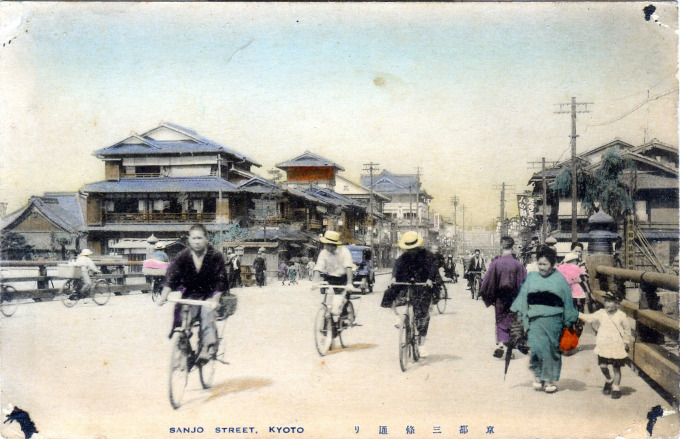From the wiki: “Sanjo Street is located in the center of Kyoto and stretches from Shinomiya in Yamashina-ku to Togetsukyo Bridge in the Arashiyama area, and is one of the oldest shopping districts in Kyoto. The Sanjo Bridge was near where three incidents tied to the Restoration took place: the Ikedaya Incident; nearby the former hideout of Sakamoto Ryōma; and near where the assassinations of Ohmura Masujiro and Sakuma Shozan took place in separate incidents.
The Ikedaya Incident
“The Ikedaya Incident, also known as the Ikedaya Affair, was an armed encounter between the shishi (literally, ‘men of high purpose’; a group of Japanese political activists of the late Edo period, including masterless samurai [ronin] formally employed by the Chōshū and Tosa clans [han]), and the Shinsengumi, the Bakufu’s special police force in Kyoto on July 8, 1864 at the Ikedaya Inn in Kyoto. The Chōshū and Tosa clans were heavily influenced by sonnō jōi (‘revere the Emperor, expel the foreign barbarians’) philosophy and supported forcibly removing all Western influences from Japan. Emperor Kōmei and the Aizu and Satsuma clans preferred a unification of the Bakufu (the Tokugawa government) and the imperial court. The shishi are alleged to have wanted to set fire to Kyoto.”
Sakamoto Ryōma
“Sakamoto Ryōma was a prominent figure in the movement to overthrow the Tokugawa shogunate during the Bakumatsu period in Japan. One of his most noted accomplishments during this period was the negotiation of peace between Chōshū and Satsuma, two powerful provinces that had long been hostile to each other, and then unite them against the Bakufu, the government that supported the Tokugawa shogun. Ryōma frequently used the alias ‘Saidani Umetarō’ during this period, as he was often hunted by Bakufu supporters and the Shinsengumi. Sakamoto was ultimately attacked and murdered in 1867, along with his companion Nakaoka Shintarō, at at the Ōmiya Inn in Kyoto.”
Ōmura Masujiro
“Under the new Meiji government, Ōmura Masujiro was appointed to the post of hyobu daiyu, which was equivalent to the role of Vice Minister of War in the newly created Army-Navy Ministry. In this role, Ōmura was tasked with the creation of a national army along Western lines. Ōmura argued that if ‘the government was determined to become militarily independent and powerful, it was necessary to abolish the fiefs and the feudal armies, to do away with the privileges of the samurai class, and to introduce universal military conscription.’ Ōmura’s ideal military consisted of an army patterned after that of the Napoleonic French armies and a navy that was patterned after the British Royal Navy.
“Ōmura faced opposition from many of his peers, including most conservative samurai who saw his ideas on modernizing and reforming the Japanese military as too radical. What Ōmura was advocating would not only end the livelihoods of thousands of samurai, but it would also mean the end of their privileged position in society. It was the opposition of some of these samurai that led to Ōmura assassination in the late 1860s. While in Kyoto looking at sites for future military schools in September 1869, Ōmura was attacked by eight disgruntled ex-samurai and was assassinated.”
Shozan Sakuma
“Born in Matsushiro, the castle town of the Matsushiro domain, Shozan Sakuma studied Chinese learning under his father, a scholar-administrator of the domain and Satō Issai, a professor at the Shōheikō, a Confucian academy in Edo (present-day Tokyo). Just like many other intellectuals of his time, Shozan was alarmed by the rising power of Western nations as illustrated by China’s humiliation in the Opium War (1839-42). The impression that this event left in him was a lasting one: Western technology, he analyzed, was the cause of the defeat of the nation whose wisdom and culture he admired. Shozan became an advocate of building a powerful modern navy and of establishing a national school system to offer everyone an education based on the ethics of Confucianism.
“As Shōzan immersed himself in the technical knowledge of the West during the 1840s, he conducted a series of experiments. Relying on the Dutch translation of a French encyclopedia by Noël Chomel, he produced glass in 1844. Following other Dutch books he later cast a Western-style bronze cannon and conducted experiments with electricity based on the elekiteru [electrostatic generator].
“In June 1864, Shozan was made an adviser to the shogunate on defense matters and went to Kyōto, then the hotbed of sonnō jōi (‘Revere the Emperor, Expel the Barbarians’) advocates. In sending Shōzan to Kyōto, the shogunate appears to have intended not only to have him serve as an adviser, but also to win the sonnō jōi faction over to the movement for union of court and shogunate. But, before he could exercise any influence on behalf of the shogunate, Shozan was assassinated by a sonnō jōi adherent, Kawakami Gensai, in Kyoto in August 1864.
“Shōzan is best remembered for his slogan Toyo dotoku, Seiyu geijutsu [‘Eastern ethics; Western technique’]. After studying Western technology and science and comparing it with Neo-Confucianism, he concluded that while they were both indispensable aspects of human knowledge, the spiritual aspect, Eastern ethics, was the more venerable. Shozan’s belief thus heralded the transformation of Japan into a modern nation, based on the blending of the old and new, of the East and West.”
– Japan Reference, 2013


